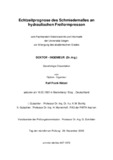Citation link:
https://nbn-resolving.org/urn:nbn:de:hbz:467-1972Files in This Item:
| File | Description | Size | Format | |
|---|---|---|---|---|
| noetzel.pdf | 6.44 MB | Adobe PDF |  View/Open |
| Dokument Type: | Doctoral Thesis | metadata.dc.title: | Echtzeitprognose des Schmiedemaßes an hydraulischen Freiformpressen | Authors: | Nötzel, Ralf | Institute: | Fachbereich 12, Elektrotechnik und Informatik | Free keywords: | Hydraulik, Schmieden, Prädiktion | Dewey Decimal Classification: | 620 Ingenieurwissenschaften und Maschinenbau | GHBS-Clases: | ZIM | Issue Date: | 2005 | Publish Date: | 2006 | Abstract: | Hydraulische Freiformschmiedepressen sind bei der Umformung von großen Stahlwerkstücken im industriellen Produktionsprozeß weit verbreitet. Die verfahrenstechnisch auftretende Forderung, ein bestimmtes vorgegebenes Umformmaß (Schmiedemaß) einzuhalten, wird dabei mit einfachen iterativ korrigierenden Schätzalgorithmen realisiert. Systembedingt führt dies zu größeren Abweichungen bei den ersten Pressenhüben. Im Rahmen der vorliegenden Dissertation wird ein Verfahren vorgestellt, welches diesen Nachteil vermeidet. Durch Messung der Verläufe des Umformweges und des Pressendruckes, während des aktuellen Umformvorganges, ist es möglich, mit einem in Echtzeit arbeitenden Parameterschätzverfahren, die zeitlichen Verläufe dieser Größen zu prognostizieren. Ein Prädiktionsmodell berechnet zyklisch das zum aktuellen Zeitpunkt erreichbare Schmiedemaß. Hat die Presse die vom Modell ermittelte Position erreicht, wird mit der Entlastung des Arbeitszylinders begonnen. Der benötigte optimale Verlauf der Ansteuerfunktion für das Schmiedeventil wird dabei während des aktuellen Pressenhubes berechnet. Die theoretisch gefundenen Ergebnisse konnten in einer Modellrechnung und mit Untersuchungen an einer Versuchsanlage bestätigt werden. Hydraulic open-die forging presses are widely used in industrial production processes for the forming of large steel workpieces. The process demand of achieving a given forming dimension (forging dimension) is satisfied here using simple iterative correcting approximation algorithms. This system, however, results in relatively large deviations in the initial press strokes. The present dissertation describes a process that enables this disadvantage to be eliminated. By measuring the curves of the forming stroke and press pressure during the momentary forming process, it is possible to predict the curves of these parameters over time using a real-time parameter approximation process. A prediction model calculates cyclically the forging dimension that can be achieved at the present time. When the press reaches the position calculated by the model, relief of the working cylinder starts. The optimum curve of the control function for the forging valve required is thereby calculated during the momentary press stroke. The theoretically calculated results have already been validated by means of a model calculation and in tests on a trial press plant. |
URN: | urn:nbn:de:hbz:467-1972 | URI: | https://dspace.ub.uni-siegen.de/handle/ubsi/197 | License: | https://dspace.ub.uni-siegen.de/static/license.txt |
| Appears in Collections: | Hochschulschriften |
This item is protected by original copyright |
Page view(s)
374
checked on Nov 30, 2024
Download(s)
477
checked on Nov 30, 2024
Google ScholarTM
Check
Items in DSpace are protected by copyright, with all rights reserved, unless otherwise indicated.

